Raising Kids on Real Food
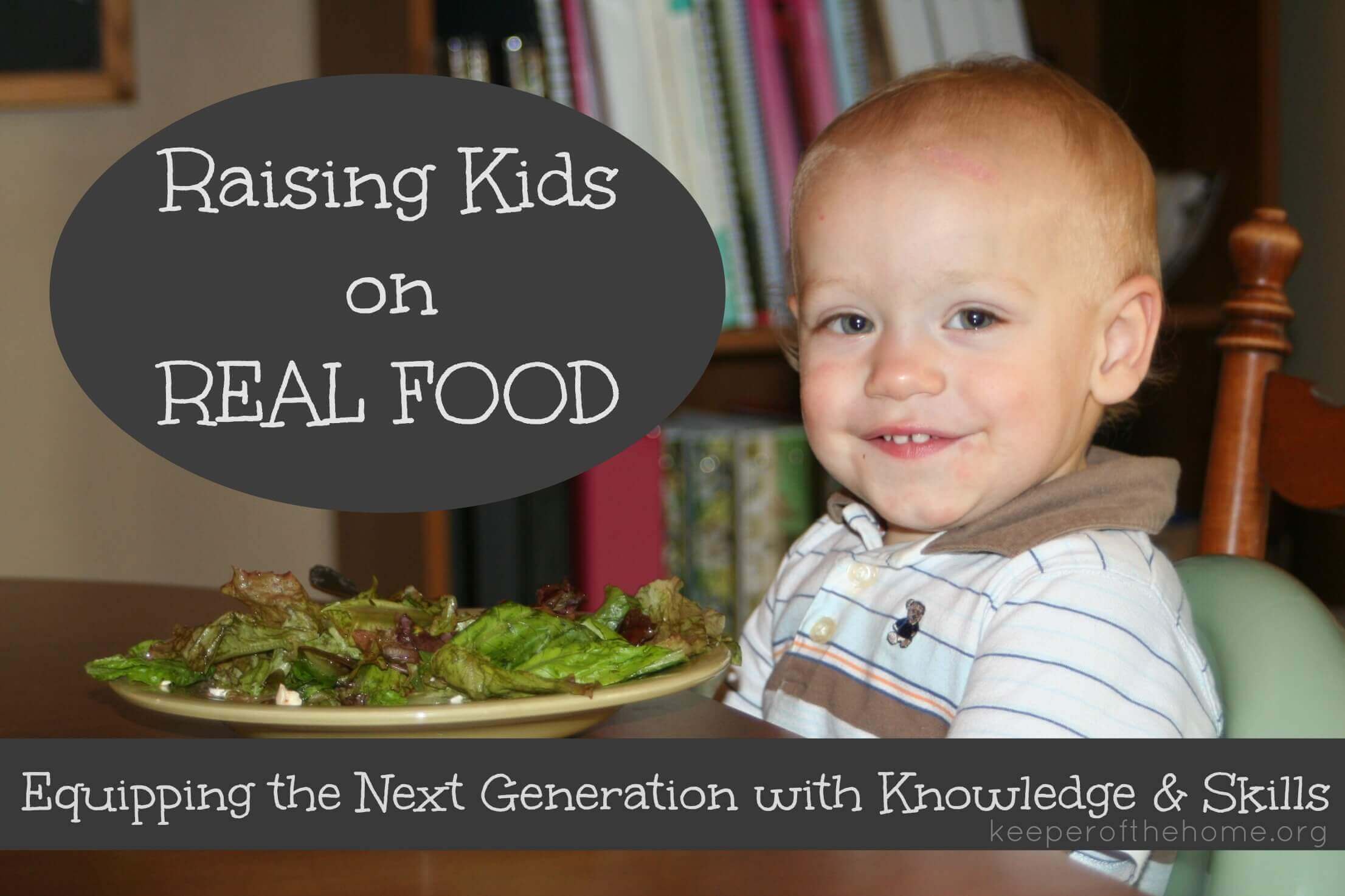
Written by Courtney Dunkin, Contributing Writer
Are you working to ditch processed foods and put more real food on the table? This month we’re running a series called Real Food Made Simple: A Beginner’s Guide to Eating Better. Our goal is to answer the questions you might have and make the transition a whole lot easier!
After several generations of playing around with the latest and greatest advancements in food technology, today’s homemaker is longing to return to real food.
Unfortunately, the modern advancements that removed us from our food left us with little knowledge on how to select and prepare it now that we want it back. Many of us are now realizing how much work it takes to simply reclaim the culinary skills and traditions that were common knowledge for thousands of years. We face many challenges as we sift through the information and return to old ways.
Mothers, take comfort in knowing this burden will be lessened for the next generation if we are intentional about passing onto our children the lost culinary arts we are learning ourselves. It can be easy to focus on the here and now of nourishing our families, but if we refocus our perspective, we can also pass on reclaimed knowledge and skills at the same time.
There are so many ways to equip the next generation. We want real food to come naturally for our children. Here are just a few aspects of making real food second nature for them.
Examine the Food Culture In Your Home
Denaturing the food supply not only stripped it of nutritional value but left it devoid of its purpose in family relationships as well. Take the convenience of a single portion microwavable dinner, for instance. No longer must we labor in love over a meal suitable for the dinner table when everyone can serve themselves at their own convenience.
Do you gather around the table as a family and engage in discussion over a meal? Or do members of your family eat at different times, maybe even sitting in front of a television instead of the table? These are just two extreme examples of different “food culture in the home.”
And at these two extremes are two very different philosophies about food. Children raised in a home with meals on the fly or in solitude will likely struggle with the temptation of processed convenience “foods” when raising a family of their own someday.
Children who are raised on whole, nourishing food, prepared and served in love over pleasant conversation and relationship will probably someday nurture their own families in the same manner.
The way in which we prepare and serve our meals is just one aspect of what I’m referring to here as “food culture in the home.”

Start Early
Some begin their real food journey in the midst of an already growing family. Great. Start where you are. Start today. And don’t dwell on guilt over mistakes you made when your children were younger.
Ideally, though, it’s best to make real food a part of our homes before we ever bear children. During the breastfeeding years, our babies are exposed to a spectrum of tastes as the flavor of our milk changes with our diet. This lays the foundation for a healthy palate. The transition to solid food should be an easy one when real food is introduced from the start.
If the taste buds are trained to recognize corn and soy jazzed up in high fructose corn syrup and MSG, the child will develop a preference for that. But if real food is served from the start, the child becomes accustomed to the wide array of flavor combinations that are possible when we are not limited to the dull culinary restrictions of processed food.
Bring Them Into the Kitchen
From a young age, children want to be involved in preparing meals. Even the simple and mundane kitchen tasks fascinate them. In the beginning, little hands will be extra work for Mom, but like anything else, with a little training, this hindrance will turn into help in no time.
These years are precious. Our children are not in our way. They are our most important work.
Capturing their attention while it’s at its peak is the best way to draw little ones into the kitchen and let them practice their culinary skills from a young age. At age two, they can handle simple tasks like grating cheese and stirring sauces. By age eight, they can prepare a full meal.
It’s so important they learn the necessary culinary skills and not just how to follow a recipe. Once they understand the basics of cooking and begin to master skills, they can break free from a dependence on cookbooks, many of which contain psuedo-homemade recipes with processed convenience ingredients.
Have you ever come across a recipe that calls for a can of something, for instance? That’s not really homemade to me. My older children know how to make a creamy soup base or to boil down milk to make evaporated milk. It’s easy as long as you’re not slave to the cookbook.
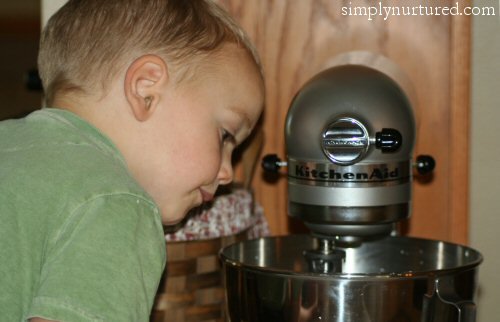
Talk About Where Food Comes From
One of the biggest problems with today’s food supply is the fact that so many people simply don’t know where their food comes from. We’re so far removed from the source that we have a hard time even recognizing real food. Some foods undergo so many changes from farm to plate that children are clueless about how it came to them.
Supermarket milk is a good example of a highly processed food. The average store-bought milk is a sterilized and homogenized mixture collected from possibly hundreds or even thousands of cows. The product is dead from a nutritional standpoint, but irritating and allergy-causing from a health standpoint.
If our children are used to getting milk fresh from the farm, on the other hand, they will grow up to have confidence in sourcing their food locally.
We know the names of the cows that give us our milk. My older daughter claims to have a preference for a certain cow’s milk, in fact. Whether this milk really is creamier and tastier or if it is just in her head, I’m not sure. But it is a good example of knowing your source.
Tending to a garden is also an excellent way to raise children to know where their food comes from. They learn so much about the natural processes our Creator put in place for us to raise a seed from soil to table year after year. It’s so much easier to grow up gardening with Mom than it is to learn everything from scratch as an adult.
Teach Them How Food Affects Health
Talking with our children about what our bodies need and what harms them is a good way to encourage good food habits and discourage bad ones. Thanks to an excellent science curriculum that explains the human body in ways I would never think of, even my four and six year olds have a basic understanding of how their bodies were designed to function and what they need for optimal performance.
They can visualize the cell as a city with each part having a special job. They can imagine white blood cells acting as warriors that fight pathogens. So when I explain that sugar is food for the bad cells that enter our bodies and that it creates more of the bad guys for the white blood cells to fight, they understand how sugar impacts immunity. From this, they are motivated to limit sugar and eat more wholesome foods. (To some degree….my children still wouldn’t turn down a candy bar!)
Older children can develop an excellent understanding of preventing and combating disease with food. If you’re on a real food journey, you’re probably immersed in information on health. Talk about it with your older children. It’s easy to teach them about food and health in everyday conversation.
Somewhere along the way, we have to make the transition from being the sole providers of our children’s nourishment and health to giving them responsibility for their own food choices. If they have the knowledge and skills to choose well and they understand how food affects them, both good and bad, they will be better equipped to make wise decisions for life.
Other posts in the series:
Real Food Made Simple: A Beginner’s Guide to Eating Better
Cutting Your Kitchen Prep Time in Half — Or More!
Confessions of a Formerly Picky Eater
The Grain Controversy: Should We Eat Them or Not?
Second Steps Towards Eating Real Foods: Switching Your Food Sources
Sweeteners: How They Affect You, Which Ones are Best, and How to Use Them
Simple Steps to Begin Cooking Homemade: Pantry Staples
5 Strategies to Help Your Husband and Kids Transition to Real Food
Finding Real Food in the Grocery Store
20 Easy Real Food Switches and Substitutions {with Free Printable Chart}
First Steps to Eating for Fertility
Keeping Costs Down in a Real Food Kitchen
5 Ways to Get More Fruits & Veggies into your Diet
Food Is Not Cheap: 4 Steps to Budgeting in Real Food
Simple Steps to Begin Cooking Homemade: Baked Goods
Simple Roast Chicken (And Fabulous Side Dish Recipes!)
17 Homemade Spice Mixes {with Recipes & Why You Should Use Them!}
5 Ways Green Living and Real Food are Connected
Simple Steps to Begin Cooking Homemade: Soups, Sauces, and Simple Dinners

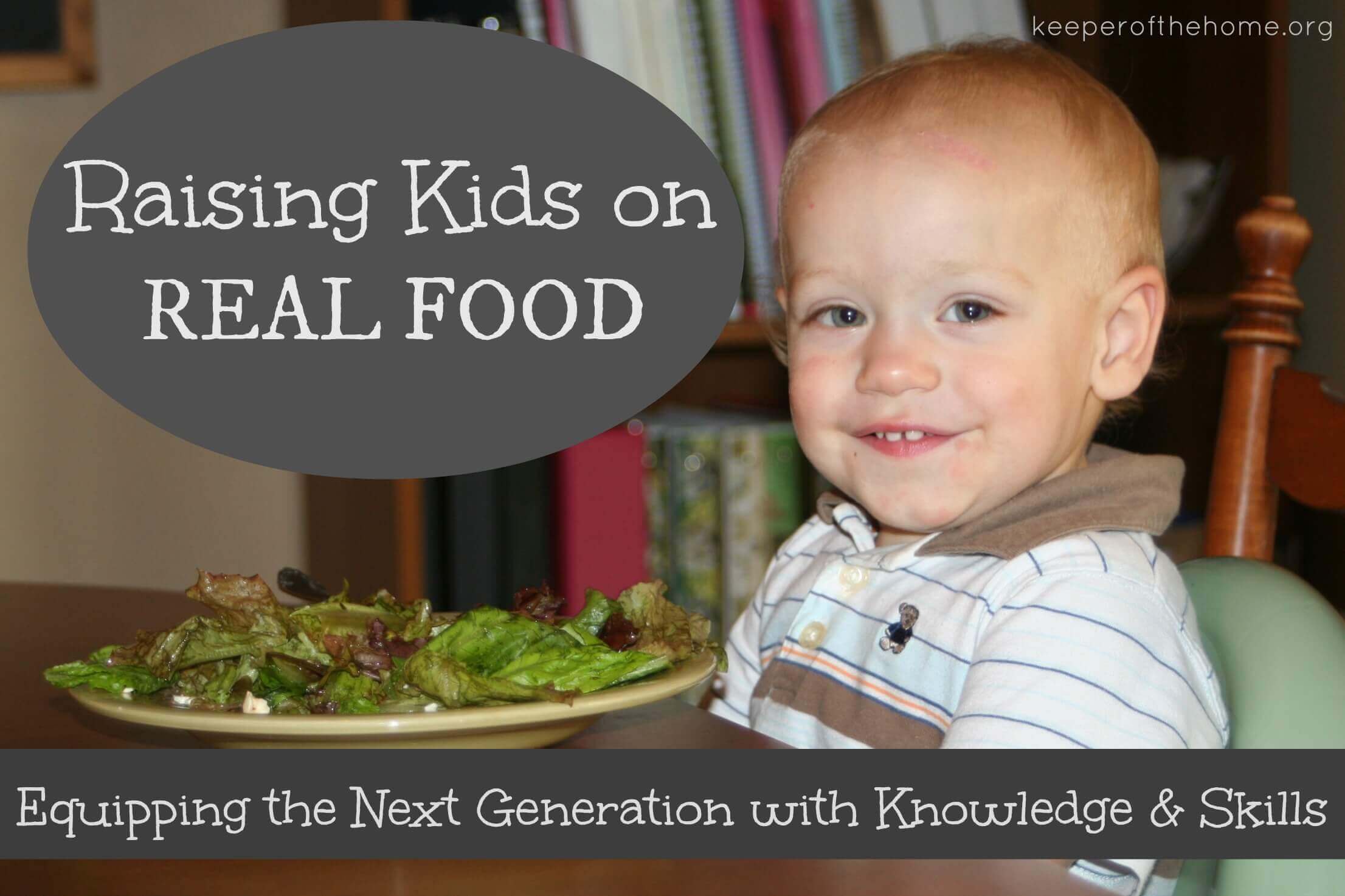
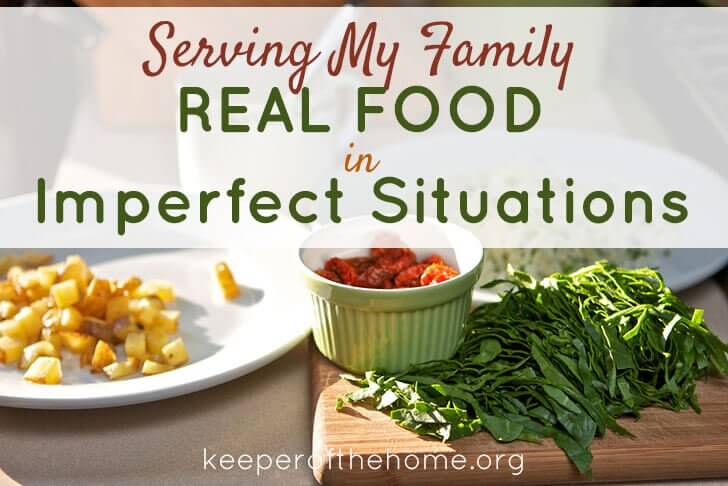

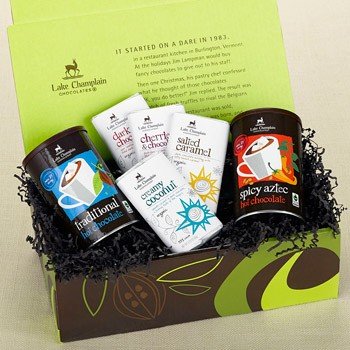
This is going to be a weird comment, but I just love the highchair. 🙂 It looks exactly like the one we have.
I don’t find it weird, I searched high and low for an antique wood high chair when pregnant with my first, I love them so much! Ours does have a square back instead of rounded though 🙂
Stacy, I love that high chair! It was actually mine when I was a baby! And it was passed down from my great-grandparents. I think they used it with my grandma and her siblings, from what I understand. After it went through me and my siblings, my aunt used it with her children, and now I have it back to use with mine! It’s falling apart, as you can see. The tray is currently broken, but my husband (a handy woodworker) has promised to fix it up as soon as possible. 🙂 I love thinking about the history in it.
Great post! I have been on the journey back to real foods myself, so all these posts have been timely! My kids love being in the kitchen with me, too! Okay, I am convinced that we need to start drinking raw milk. I know it’s hard to get in Texas, so I’ve got to do some research. Thanks for that extra nudge that I needed!
Kids love being in the kitchen, so if we embrace that, we can turn it into something great! 🙂
I thought Texas was more laid back on raw milk. Maybe I’m wrong. I hope you find a good source! It’s worth it, for the health benefits AND the taste.
We live in WI and the closest place to find raw milk is an hour away. It’s like it’s an illegal drug-ridiculous.
We live in WI and the closest place to find raw milk is an hour away. It’s like it’s an illegal drug-ridiculous.
I have to say, that is one of the great blessings about Washington state – we have multiple farmers in a 10 miles radius that sell it. Getting to visit the farm and get our milk is just wonderful – I hope we can see a change in this country and see it available again everywhere!
And great post!
Love this post! Although allowing kids to participate in the cooking takes more time and energy, I’m hoping it’s worth it in the long run. 🙂 And it’s pretty precious to see my 2 1/2 year old don her apron and climb on a chair to “help mommy.” Thanks for the reminder of the importance of creating a good “food culture;” hopefully, all that prep time is creating not only hearty meals, but an atmosphere of love.
Absolutely! That atmosphere of love and the relationships that we cultivate in the kitchen are so precious. Since I’m seeing the benefit of all that now that I have older children as well, I have more patience with the younger ones and realize that even though it takes more time, it’s well worth it for many reasons. Little ones in aprons never fail to melt my heart!
“And don’t dwell on guilt over mistakes you made when your children were younger.” This is really important. For those who are just starting on this real food journey, there is a lot of guilt over “what should have been.” I can’t dwell on the formula I gave my babies, or the soy milk I fed my daughter for a year. I just have to pick up where I am and move forward, armed with knowledge!
That’s the truth! And I have a hard time swallowing that in all areas of my life. I’m a work in progress. Honestly, though, the guilt is what trips us up so much of the time. 🙂
I love this post! I have been including my oldest in the kitchen since he was about 18 months. He would sit on the counter and help mix ingredients, or put cut up veggies from the garden into a bowl for me. Although the reality was that he sat on the counter and ate everything that I gave him to help with. 🙂 He’ll be three soon, and still loves to help me in the kitchen. He is learning more and more. Last night for the super bowl we made soft pretzels. I can now give him a measuring cup or spoon and show him which ingredient to use. He will measure and start to mix everything together ( I still need to do the final mix and kneading to make sure everything is incorporated). He still will eat whatever he is preparing, that part has not changed! 😉
Yep, that’s the reality of it. They sit there and eat as much as they can. It really does take more time and effort on our part in those early years, doesn’t it? 🙂 But it does pay off in the long run. My three year old has to carry our kitchen step stool around the kitchen to help us. Almost daily he sets that thing down on someone’s foot and steps on it. It is painful! But these are fun days regardless of all that.
TRUTH!!! Loved all of this. TEACHING them – I believe in that with all my heart. I hope my kids carry their love and knowledge of whole foods with them throughout ALL of life 🙂 Newer follower – I’m enjoying your space!!!
Thank you!! 🙂 I hope my children carry this knowledge and passion for real food throughout life, too. We’ve nurtured a lot of relationships in the kitchen, the “gathering place”, so I think that’s one of the biggest things that will contribute to their own passion for food and patience to do it right. Teaching them young is the way to do it. 🙂
Great post! My wife and I have really been enjoying this ‘real food’ series. I really liked your point about teaching children about real food, truly nourishing them, and they will continue those habits as adults. My Mom always prepared meals for our family and taught us how to cook if we were interested in learning. I went astray for a while with my eating habits, but for the last year or so have really been enjoying preparing meals at home with our five year old. The facts are hard to argue with…real food takes more time but is more cost efficient. Our whole family feels better, healthier, more energetic when we are eating real food.
Yes, that is so true. Real food takes more time but is more cost efficient. I think it’s wonderful when children start to really make that connection between what they eat and how they feel!
Excellent job on this post. I thought it was very thoughtful and brought to light some unique points! Grateful for the science curriculum post!
When my oldest was nursing, we found out he was allergic to milk and my milk supply just plummeted as I changed my diet. (Probably due to stress more than anything else.) i HATED the idea of soy formula, but did not know what else to do. He actually thrived on this formula and is a very healthy eater now. I sure would never recommend that formula, but sure am glad that the Lord took care of him even with that awful stuff!
Thanks again for a great post.
Thank you. And yes, indeed! The Lord is in control and can redeem our past mistakes here, too. I’ve made quite a few with my own children! It can be so easy to dwell on guilt over poor choices in past pregnancies or in the early years, so it is so important to remind moms to let that go and focus on what we can do now.
Stephanie, what a healthy way to get kids to enjoy food!
I talk alot with my twins about where food comes from, how it’s made and am starting to explain to them about the importance of making good food choices for their overall health. They are young and I don’t expect them to get it but slowly over time I am hoping it will sink in. On a funny note, on our way to school last week we were talking about how foods made in factories are not good for you but foods that are grown in the ground or on trees or bushes are good for me. Then we played a game of “name that food that is good for you and where it’s grown” and they tossed out bananas, apples, strawberries, nuts, etc. Very seriously, one of the twins asked me, “But Mom, where do the chocolate chips grow from the ground?” You could tell that she thought they were good for you but couldn’t figure out where they grew. It made me laugh.
I love it! We enjoy talking about where food comes from all the time. I’ll have to play that little game with them now. 🙂 I think it’s so cute when little ones start to figure out where food comes from, especially when they think things like chocolate chips grow from the ground. When planning and planting the garden, I’ve had my kids tell me they want to grow foods like that.
I really need to do a better job of including my children in the cooking. I have a galley kitchen and it often feels tight with just me in there, but I would hate for them to have to learn it all on their own like I did, it would create such a better launch into adult life if they already knew how before they left our home. This article reminded me I need to fight my tendency to just want to cook it all myself because I hate feeling crammed in my tight kitchen, and diligently teach my children to cook.
I really love this post. My daughter is 1 year old, and she has had nothing but breastmillk and real food. Dr. ‘s have been amazed at how healthy she is. It is sad to me that so many children grow up on convenience food.
In our home we include her in meal time and making meals. We sit down as a family. When I am making dinner I tell her what I am doing, I give her a spatula to play with in the kitchen while I make the food. When she is older, she can help with the actual making of the meal 🙂
Very good blog. We are just now starting to clean up our diets and I am seeing a lot of progress. My husband lost 17 lbs in the past month or so and my daughters have lost some of their bellies. They weren’t horribly overweight but I know that a lot of it was too much sugar and carbs. Even though we hardly eat out, we still were overeating-too much meat, carbs etc. We also were eating candy every Thursday night for movie night and I didn’t realize we were spending about $28/month just on candy! (there are 6 of us) Then the snacks after church, the Friday night desserts, cinnamon rolls on Sunday etc. Those things are okay in moderation. My kids balked at first but it didn’t take long to adjust. I am making most things from scratch and we don’t feel we have to have bread everyday. I l make pancakes with lots of protein and very little flour(some of us dealing with candida issues) I had to get kind of “mean” and strict and now they know at church they can have one dessert not several. I was scared to do this b/c I didn’t want them to get an eating disorder b/c I have struggled with that but we never pointed out that they needed to lose weight, just focused on moderation and exercise. They want to help their Dad too as he was having several health problems due to being overweight. It’s not perfect but it’s exciting to see that you can make real changes! They were so addicted to cereal, bread etc that they were hungry ALL THE TIME! It was driving me crazy!
On another note, I never could breastfeed for very long and had to use formula but like the above post, I prayed about it and my kids are really healthy considering. Good genes help too but I know God knew my heart that I desperately wanted to bf. So those of you just starting out, you can do it, don’t get obsessed (we can only afford some organic items) and do the best you can.
I’ll take it one step further and say what we eat while pregnant shapes our children’s taste buds! Our diet affects the taste of our amniotic fluid and our babies taste the fluid, so our diet as moms affects them EARLY! 🙂